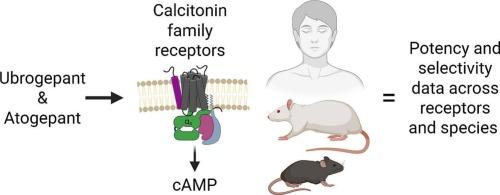Pharmacological characterization of ubrogepant and atogepant in cAMP assays at human, rat, and mouse calcitonin family receptors in transfected cells
IF 5.6
2区 医学
Q1 PHARMACOLOGY & PHARMACY
引用次数: 0
Abstract
Calcitonin gene-related peptide (CGRP) is involved in migraine pathophysiology, and can activate multiple receptors belonging to the calcitonin receptor family; this includes the CGRP receptor, adrenomedullin and amylin (AMY) receptors. Ubrogepant and atogepant, which were designed to target the CGRP receptor, are therapeutically approved for the management of migraine. However, there are limited data on their ability to antagonize members of the wider calcitonin receptor family. We therefore defined the receptor pharmacology of ubrogepant and atogepant at each of the seven calcitonin family receptors from rat, mouse and human. Cos7 cells transiently transfected with each receptor were exposed to species-matched agonists in the absence or presence of ubrogepant and atogepant. As all receptors robustly couple to the Gαs G protein, cyclic adenosine monophosphate production was measured and antagonist potency quantified. Ubrogepant and atogepant antagonized multiple rodent receptors, although the exact profile differed between compound and species. Both compounds were relatively non-selective between rat receptors, suggesting it may be difficult to interpret results in rat models. Selectivity was distinct at mouse receptors. For human receptors, both compounds were most potent at the CGRP receptor, however there was also some affinity at other receptors from this family, especially the AMY1 receptor. Collectively, our data show that while these compounds are most potent at the CGRP receptor, they have activity at other receptors from the calcitonin receptor family, and this activity differs between species. Our data provide a framework for understanding the activity of ubrogepant and atogepant in rat, mouse and human studies.

人、大鼠和小鼠降钙素家族受体在转染细胞中的cAMP测定中增厚剂和增厚剂的药理学特征。
降钙素基因相关肽(CGRP)参与偏头痛病理生理,可激活降钙素受体家族的多种受体;这包括CGRP受体,肾上腺髓质素和amyin (AMY)受体。ubrogetant和atogetant是设计用来靶向CGRP受体的,被批准用于治疗偏头痛。然而,关于它们拮抗更广泛的降钙素受体家族成员的能力的数据有限。因此,我们从大鼠、小鼠和人的降钙素家族7个受体中分别确定了增厚剂和增厚剂的受体药理学。短暂转染每种受体的Cos7细胞在没有或存在增生剂和同增生剂的情况下暴露于物种匹配的激动剂。由于所有受体都与Gαs G蛋白偶联,因此测量了环磷酸腺苷的产生并定量了拮抗剂的效价。ubrogeagent和atogeagent拮抗多种啮齿动物受体,虽然确切的轮廓在化合物和物种之间有所不同。这两种化合物在大鼠受体之间具有相对的非选择性,这表明在大鼠模型中可能难以解释结果。对小鼠受体有明显的选择性。对于人类受体,这两种化合物对CGRP受体最有效,但对该家族的其他受体也有一定的亲和力,尤其是AMY1受体。总的来说,我们的数据表明,虽然这些化合物对CGRP受体最有效,但它们对降钙素受体家族的其他受体也有活性,而且这种活性因物种而异。我们的数据提供了一个框架,以了解在大鼠,小鼠和人类研究中增殖剂和共生剂的活性。
本文章由计算机程序翻译,如有差异,请以英文原文为准。
求助全文
约1分钟内获得全文
求助全文
来源期刊

Biochemical pharmacology
医学-药学
CiteScore
10.30
自引率
1.70%
发文量
420
审稿时长
17 days
期刊介绍:
Biochemical Pharmacology publishes original research findings, Commentaries and review articles related to the elucidation of cellular and tissue function(s) at the biochemical and molecular levels, the modification of cellular phenotype(s) by genetic, transcriptional/translational or drug/compound-induced modifications, as well as the pharmacodynamics and pharmacokinetics of xenobiotics and drugs, the latter including both small molecules and biologics.
The journal''s target audience includes scientists engaged in the identification and study of the mechanisms of action of xenobiotics, biologics and drugs and in the drug discovery and development process.
All areas of cellular biology and cellular, tissue/organ and whole animal pharmacology fall within the scope of the journal. Drug classes covered include anti-infectives, anti-inflammatory agents, chemotherapeutics, cardiovascular, endocrinological, immunological, metabolic, neurological and psychiatric drugs, as well as research on drug metabolism and kinetics. While medicinal chemistry is a topic of complimentary interest, manuscripts in this area must contain sufficient biological data to characterize pharmacologically the compounds reported. Submissions describing work focused predominately on chemical synthesis and molecular modeling will not be considered for review.
While particular emphasis is placed on reporting the results of molecular and biochemical studies, research involving the use of tissue and animal models of human pathophysiology and toxicology is of interest to the extent that it helps define drug mechanisms of action, safety and efficacy.
 求助内容:
求助内容: 应助结果提醒方式:
应助结果提醒方式:


